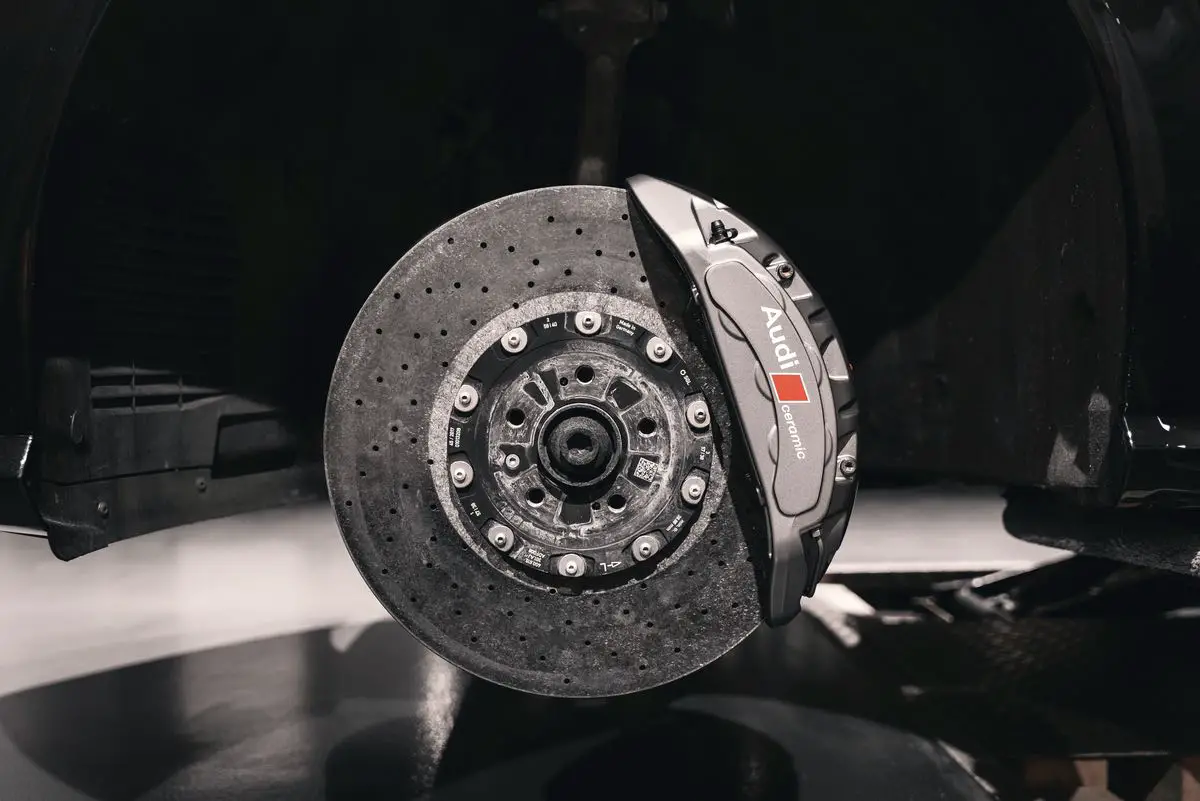The First Car with Disc Brakes
Learn about the first car to feature disc brakes and how this innovation revolutionized automotive safety and performance. Explore the history and impact of disc brakes in the automotive industry.

The history of automotive innovation is marked by countless milestones that have shaped the way we drive today. Among these, the introduction of disc brakes stands out as a transformative moment in automotive safety and performance.
The first commercially available car with disc brakes, the 1955 Citroën DS, revolutionized braking technology and set a new standard for vehicle safety and efficiency.
As we delve into the story of disc brakes, we explore their invention, adoption, and lasting impact on the automotive industry.
A Short Introduction to Disc Brakes
Disc brakes are a type of braking system that use a rotor, which is attached to the wheel, and calipers, which house the brake pads. When the brake pedal is pressed, the calipers squeeze the brake pads against the rotor, creating friction that slows the wheel's rotation.
This design offers several advantages over traditional drum brakes, including better heat dissipation, more consistent braking performance, and reduced risk of brake fade. The disc brake system is composed of several key components: the rotor, caliper, brake pads, and hydraulic system.
The rotor is typically made of cast iron or composites and is designed to withstand high temperatures. The calipers, usually made of metal, hold the brake pads and apply pressure to the rotor. The brake pads, which are made of friction materials, are the components that actually contact the rotor to create the braking force. The hydraulic system uses brake fluid to transfer the force from the brake pedal to the calipers, ensuring efficient and responsive braking. A major advantage of disc brakes is that the brake components cool down more quickly since they are exposed to air, which helps with heat management.
This combination of components results in a braking system that is not only more efficient but also more reliable under various driving conditions.
The Importance of Braking Systems in Automotive Safety
Braking systems are essential for vehicle safety and performance, providing drivers with the ability to control speed and stop effectively under various conditions. Effective braking systems enhance overall safety by preventing accidents and ensuring drivers can respond to unexpected situations.
Over the years, engineers have continually improved these systems to meet the demands of modern driving, which include higher speeds and increased traffic. The evolution of braking technology, from early mechanical systems to advanced hydraulic and electronic systems, reflects the ongoing effort to enhance safety and reliability.
Key innovations, such as anti-lock braking systems (ABS) and electronic brakeforce distribution (EBD), have been integrated with traditional braking components to offer even greater control and stability. These advancements help prevent skidding and loss of control, especially in adverse weather conditions. In performance vehicles, advanced braking systems allow for precise control during high-speed maneuvers, making driving not only safer but also more enjoyable.
The constant focus on improving braking technology underscores its critical role in automotive engineering, ensuring that vehicles are equipped to handle the demands of today’s roads while providing drivers with the confidence to navigate any situation safely.
Early Brake Technologies and Their Limitations
Before disc brakes, drum brakes were the standard technology in automobiles. Drum brakes created friction between a rotating drum and stationary shoes to slow the vehicle. While functional, they had several limitations.
One major issue was brake fade, which occurred when the brakes overheated after repeated use, causing a significant drop in braking efficiency. This was particularly dangerous in scenarios requiring frequent braking, such as driving downhill or stopping suddenly from high speeds.
Additionally, drum brakes were more susceptible to wear and tear, necessitating frequent maintenance and adjustments. These issues highlighted the need for a more reliable and efficient braking system.
The Invention of Disc Brakes
The development of disc brakes addressed many of the limitations associated with drum brakes. Unlike drum brakes, which rely on friction between a rotating drum and stationary shoes, disc brakes use a rotor and calipers to provide more consistent stopping power. This design allows for better heat dissipation, reducing the risk of brake fade.
The concept of disc brakes had been around since the early 20th century, but it wasn't until the mid-1950s that they were first implemented in a mass-produced car. Early iterations of disc brakes appeared on racing and specialty vehicles, showcasing their potential to enhance braking performance under extreme conditions.
The Jaguar C-type was the car that pioneered disc brake technology in 1952 . The C-type won the Le Mans 24 hours race twice but it was not a mass-produced consumer car.

It was the Citroën DS that brought this innovative technology to the consumer market, proving its effectiveness and reliability in everyday driving. The DS's success demonstrated that disc brakes could meet the rigorous demands of both performance and safety, paving the way for their widespread adoption across the automotive industry. As a result, disc brakes have become a cornerstone of modern braking systems, continuously evolving to meet the needs of contemporary vehicles.

The First Car to Feature Disc Brakes
The first car with disc brakes was the 1955 Citroën DS. According to Richard Lentinello, an automotive historian, this innovative vehicle set the benchmark for safety and performance with its advanced braking system. The introduction of disc brakes marked a significant shift in the automotive industry, prompting manufacturers to prioritize safety innovations.

As a result, the technology continued to evolve, leading to even more efficient and reliable braking systems in today's vehicles. The Citroën DS was not only ahead of its time in terms of design and technology, but it also demonstrated the effectiveness of disc brakes in everyday driving situations.
The DS quickly gained a reputation for its smooth ride and impressive stopping power, becoming a favorite among drivers and automotive enthusiasts alike.
Impact on Vehicle Performance and Safety
The introduction of disc brakes on the Citroën DS had a significant impact on both vehicle performance and safety.
Over the course of 20 years, the Citroën DS sold 1.5 million units with the same brake setup, highlighting the sustained success and reliability of disc brakes in mass production. The enhanced stopping power and reduced brake fade of disc brakes made them a popular choice for high-performance and sports cars, where precision braking is crucial. Additionally, disc brakes contributed to shorter stopping distances, making driving safer for everyone on the road.
This advancement was particularly beneficial in emergency situations, where every second counts. As disc brakes became more widespread, they set a new standard for automotive braking systems, influencing the design and technology of future vehicles.
Adoption by the Automotive Industry
The success of the Citroën DS's disc brakes quickly caught the attention of other car manufacturers. Initially, disc brakes were reserved for high-performance and luxury vehicles due to their superior braking capabilities and higher production costs.
However, as the benefits of disc brakes became increasingly evident—such as enhanced stopping power and reduced brake fade—more manufacturers began to incorporate this technology into their designs. The shift was further accelerated by improvements in manufacturing processes and material sciences, which helped lower production costs and made disc brakes more accessible for a broader range of vehicles.
In the 1960s and 1970s, many European carmakers, including Jaguar and Porsche, started to equip their sports cars with disc brakes to meet the demands of high-speed driving and racing. American manufacturers soon followed suit, integrating disc brakes into models that required robust braking systems to handle higher speeds and heavier weights. By the late 20th century, disc brakes had become more common in mainstream passenger vehicles, largely due to their proven reliability and performance advantages over traditional drum brakes.
The transition to disc brakes represented a paradigm shift in automotive engineering. Manufacturers began to prioritize not just speed and aesthetics but also the safety and performance enhancements that disc brakes provided. This led to a surge in innovation as engineers sought to improve braking systems further, integrating them with emerging technologies like anti-lock braking systems (ABS) and electronic stability control (ESC). These advancements have made disc brakes an integral component of modern vehicles, contributing to the overall safety and reliability of the automotive industry.

Modern-Day Braking Systems
Today's vehicles are equipped with braking systems that reflect decades of innovation and advancement. Modern disc brakes benefit from high-performance materials such as carbon-ceramic composites, which offer exceptional durability and resistance to heat. These materials are especially prevalent in high-end sports cars and performance vehicles, providing superior stopping power and longevity.
In addition to advancements in materials, modern braking systems incorporate cutting-edge technologies that enhance safety and control. Anti-lock braking systems (ABS) prevent wheel lock-up during hard braking, allowing drivers to maintain steering control and avoid skidding. Electronic brakeforce distribution (EBD) optimizes brake force across all wheels, ensuring balanced braking and improved stability, especially under heavy loads or varying road conditions.

Another significant development is the integration of regenerative braking in electric and hybrid vehicles. This technology converts kinetic energy into electrical energy during braking, which is then stored in the vehicle's battery. Regenerative braking not only enhances energy efficiency but also reduces wear on the brake components, extending their lifespan.
Brake-by-wire systems are also emerging, replacing traditional hydraulic systems with electronic controls. This technology provides more precise braking response and allows for easier integration with other electronic safety systems, such as electronic stability control (ESC) and advanced driver assistance systems (ADAS).
The evolution of braking technology continues with the development of autonomous and semi-autonomous vehicles. These vehicles rely on sophisticated braking systems capable of responding to real-time data from sensors and cameras, ensuring safe and efficient operation without direct driver input.
As automotive technology advances, braking systems remain a focal point for engineers and manufacturers, continually improving to meet the demands of modern driving and enhancing overall vehicle safety and performance.
Summary
Jaguar first introduced disc brakes on their C-type model in 1952. However, the the Citroën DS, introduced in 1955, marked a transformative milestone by being the first consumer car equipped with disc brakes. This innovation significantly enhanced vehicle safety and performance, showcasing the advantages of disc brakes in everyday driving.

Over the years, disc brakes have become synonymous with safety and performance, influencing countless innovations in automotive engineering. The success of the Citroën DS highlighted the need for reliable and efficient braking systems, paving the way for the widespread adoption of disc brakes across the automotive industry. The evolution of braking technology did not stop there; modern advancements like ABS, EBD, and regenerative braking systems continue to push the boundaries of vehicle safety and efficiency.
As braking technology advances, engineers and manufacturers are constantly innovating to meet the demands of modern driving, ensuring that vehicles are equipped with the latest safety features. From high-performance sports cars to everyday passenger vehicles, the impact of disc brakes is undeniable. The legacy of the first car with disc brakes is evident in today’s braking systems, which are more reliable, efficient, and advanced than ever before.
In conclusion, the introduction of disc brakes on the Citroën DS was a game-changer in the automotive world. This pivotal innovation set a new standard for vehicle safety and performance, influencing the design and functionality of braking systems for decades. The advancements in braking technology continue to ensure that vehicles are safer and more reliable, promising a secure driving experience for future generations.





